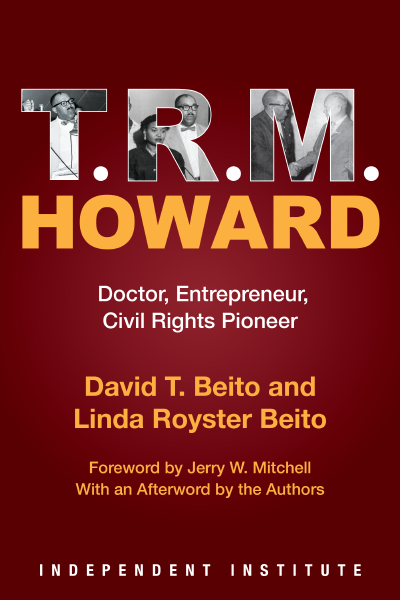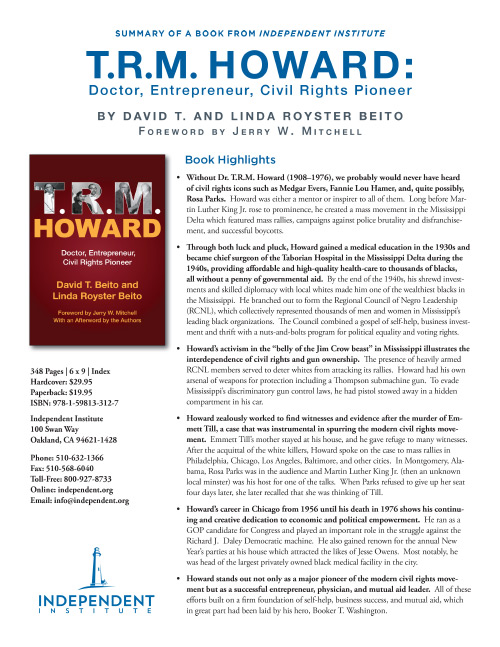Highlights
- Without Dr. T.R.M. Howard (1908–1976), we probably would never have heard of civil rights icons such as Medgar Evers, Fannie Lou Hamer, and, quite possibly, Rosa Parks. Howard was either a mentor or inspirer to all of them. Long before Martin Luther King Jr. rose to prominence, he created a mass movement in the Mississippi Delta which featured mass rallies, campaigns against police brutality and disfranchisement, and successful boycotts.
- Through both luck and pluck, Howard gained a medical education in the 1930s and became chief surgeon of the Taborian Hospital in the Mississippi Delta during the 1940s, providing a ordable and high-quality health-care to thousands of blacks, all without a penny of governmental aid. By the end of the 1940s, his shrewd investments and skilled diplomacy with local whites made him one of the wealthiest blacks in the Mississippi. He branched out to form the Regional Council of Negro Leadership (RCNL), which collectively represented thousands of men and women in Mississippi’s leading black organizations. The Council combined a gospel of self-help, business investment and thrift with a nuts-and-bolts program for political equality and voting rights.
- Howard’s activism in the “belly of the Jim Crow beast” in Mississippi illustrates the interdependence of civil rights and gun ownership. The presence of heavily armed RCNL members served to deter whites from attacking its rallies. Howard had his own arsenal of weapons for protection including a Thompson submachine gun. To evade Mississippi’s discriminatory gun control laws, he had pistol stowed away in a hidden compartment in his car.
- Howard zealously worked to find witnesses and evidence after the murder of Emmett Till, a case that was instrumental in spurring the modern civil rights movement. Emmett Till’s mother stayed at his house, and he gave refuge to many witnesses. After the acquittal of the white killers, Howard spoke on the case to mass rallies in Philadelphia, Chicago, Los Angeles, Baltimore, and other cities. In Montgomery, Alabama, Rosa Parks was in the audience and Martin Luther King Jr. (then an unknown local minster) was his host for one of the talks. When Parks refused to give up her seat four days later, she later recalled that she was thinking of Till.
- Howard’s career in Chicago from 1956 until his death in 1976 shows his continuing and creative dedication to economic and political empowerment. He ran as a GOP candidate for Congress and played an important role in the struggle against the Richard J. Daley Democratic machine. He also gained renown for the annual New Year’s parties at his house which attracted the likes of Jesse Owens. Most notably, he was head of the largest privately owned black medical facility in the city.
- Howard stands out not only as a major pioneer of the modern civil rights movement but as a successful entrepreneur, physician, and mutual aid leader. All of these efforts built on a foundation of self-help, business success, and mutual aid, which in great part had been laid by his hero, Booker T. Washington.
Synopsis
If T.R.M. Howard were the protagonist of a bestselling novel, readers would be captivated but critics would dismiss him as too unlikely, too unbelievable. With his quick mind and boundless energy he excelled in whatever realm he pursued—be it hunting, medicine, public speaking, business, opinion journalism, or political activism. And he was always close to controversy.
Howard’s larger-than-life story has never been told better than in T.R.M. Howard: Doctor, Entrepreneur, and Civil Rights Pioneer, by historians David T. and Linda Royster Beito.
Born into poverty, Howard was a renaissance man of twentieth-century black history who founded hospitals and medical associations, launched a variety of successful enterprises that made him one of the wealthiest African-Americans in Mississippi, organized statewide boycotts, mentored civil rights activists such as Medgar Evers, who was later assassinated by a Klansman, and inspired the likes of Rosa Parks.
Howard sometimes disagreed about strategy with Martin Luther King Jr., but he drew the wrath of J. Edgar Hoover, who denounced him in an open letter for criticizing the FBI’s refusal to investigate the murder of Emmett Till. Yet despite the seriousness of his battles and achievements, Howard was well known for his benevolence, fun-loving lifestyle, and fabulous parties attended by celebrities such as Jesse Owens and Jackie Robinson.
T.R.M. Howard tells more than the story of a single man. It also brings to the fore the heroic contributions of black entrepreneurs and professionals during the civil rights era, a role often neglected by historians. Meticulously researched and lucidly written, its narrative of men and women pursuing equal justice and economic betterment offers hope and inspiration as Americans consider the next steps for securing liberty and justice for all.
Origins and Ascent
Howard’s childhood in the Black Patch of Western Kentucky was one of poverty and violence. His father was a tobacco twister and his mother was a cook for Will Mason, a local white doctor who was also a Seventh-day Adventist. The Howard family depended on young Theodore’s hunting skills to bring food to the dinner table. Just shy of his ninth birthday, Howard had personal experience with a near lynching that was stopped only by a personal visit of the governor to the city of Murray. Dr. Mason noticed the boy’s talents, put him to work in his hospital’s bakery, and helped to get him into Seventh-day Adventist colleges. In homage, Howard later added “Mason” as one of his middle names.
Howard was the only black student in the 1930s at Loma Linda University, an Adventist medical school in Southern California. While there, he took part in civil rights and political causes and wrote a regular column for the California Eagle, the leading black newspaper in Los Angeles. As president of the California, Economic, and Political League, Howard championed black business ownership and opposed local efforts to impose segregation. He also married the prominent black socialite, Helen Nela Boyd. The Howards were married for forty-one years and adopted one child. Howard also he fathered several children out of wedlock with other women.
Doctor, Entrepreneur, Civil Rights Poineer
In 1942, Howard became chief surgeon of the hospital of the Knights and Daughters of Tabor, a fraternal organization in the all-black town of Mound Bayou, Mississippi. The Taborian Hospital gave affordable and accessible health-care to the Delta’s impoverished black population. During the same period, Howard founded an insurance company, restaurant, home construction firm, and a large farm where he raised cattle, quail, hunting dogs, and cotton. He built a small zoo and a park, as well as the first swimming pool for blacks in Mississippi. In 1947 he broke with the Knights and organized the United Order of Friendship which founded the Friendship Clinic.
Howard rose to civil-rights prominence after founding the Regional Council of Negro Leadership (RCNL) in 1951. His compatriots in the Council included Medgar Evers, whom Howard hired as an agent for his company, the Magnolia Mutual Life Insurance Company, and Aaron Henry, a future leader in the Mississippi Freedom Democratic Party. The RCNL mounted a successful boycott against service stations that denied the use of restrooms to blacks, distributing some twenty thousand bumper stickers with the slogan, “Don’t Buy Gas Where You Can’t Use the Restroom.”
The group also organized yearly rallies in Mound Bayou for civil rights, which drew as many as ten thousand people, including budding activists such as Fannie Lou Hamer and Amzie Moore. Rally speakers included U.S. congressmen William L. Dawson and Charles C. Diggs, Chicago Alderman Archibald Carey Jr., and NAACP attorney Thurgood Marshall. One of the entertainers was Mahalia Jackson.
In 1954, the RCNL campaigned in Mississippi for immediate implementation of the Supreme Court’s decision in Brown v. Board of Education. That push encountered fierce economic pressure from the racist white Citizens’ Councils. At Howard’s suggestion, the NAACP encouraged businesses, churches, and voluntary associations to transfer their accounts to the black-owned Tri-State Bank of Memphis. The plan infused much-needed aid to victims of economic pressure. Howard also served as chairman of the board of the National Negro Business League, the black version of the chamber of commerce.
The Murder of Emmet Till
The next year, Howard moved into the national spotlight following the murder of Emmett Till and the September trial of his killers J. W. Milam and Roy Bryant. Howard helped direct the search for evidence, and his home was a “black command center” for witnesses and journalists. Visitors noticed the high level of security, including armed guards and a plethora of weapons. Emmett’s mother, Mamie Till (Mobley), and Charles Diggs stayed at his home when they came to testify. Howard alleged that more than two people took part in the crime.
After an all-white jury acquitted Milam and Bryant, Howard gave many speeches nationwide on Till’s murder and other examples of racial violence. One of these was in Montgomery, Alabama, on November 27, 1955, and was hosted by Martin Luther King Jr. Rosa Parks, who attended, later recalled that she was thinking of Emmett Till when she refused to give her seat four days after hearing Howard.
In early 1956, the Chicago Defender awarded Howard the top spot on its annual national honor role. Martin Luther King Jr. was not on the list. Meanwhile Howard and his family increasingly faced death threats and economic pressure. In speeches and writings, he put forward the (now proven) theory that more than two people took part in Emmett Till’s murder. He continued to push for reopening of the case, but without success.
Taking on the Chicago Machine
Howard’s move to Chicago in 1956 opened another chapter in his eventful life. He founded the profitable Howard Medical Center on the South Side and served as president of the National Medical Association, the black counterpart of the American Medical Association. In 1958 he ran for the U.S. House of Representatives as a Republican against the powerful black Democratic incumbent Democrat William L. Dawson, a close ally of Chicago mayor Richard J. Daley.
Meanwhile, Howard helped found the Chicago League of Negro Voters, which nurtured the black independent movement of the 1960s and 1970s that eventually propelled several of Howard’s friends to higher office, including future mayor Harold Washington. In 1965, Howard chaired a Chicago committee to raise money for the children of the recently assassinated leader Malcolm X. Most controversially, he also became well known as a leading abortion provider. Howard regarded this work as complementary to his earlier civil rights activism.
Coda
Howard was a big-game hunter and made several trips to Africa for such hunting. His Chicago mansion, which he often opened for tours, included a “Safari Room” filled with trophies. Rev. Jesse Jackson found Operation Push there in 1971, and Howard was one of its officers and an important donor. The New Year parties of the Howards were a regular stop for Chicago’s black social elite. In 1972, he founded the Friendship Medical Center on the South Side. It was the largest privately owned black clinic in Chicago and boasted a staff of 160. He died in 1976.








